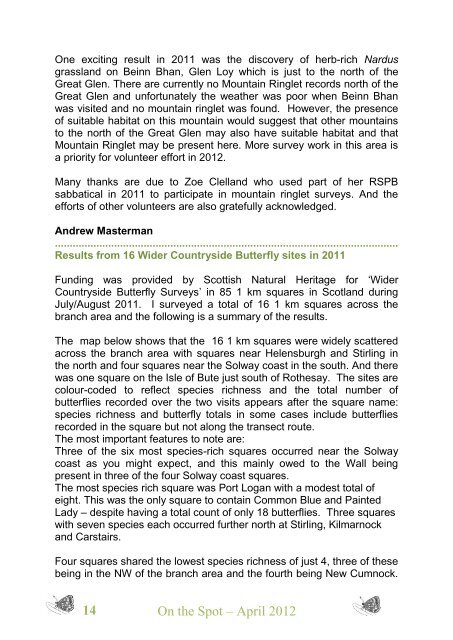Spring 2012 - Glasgow & SW Scotland Branch of Butterfly ...
Spring 2012 - Glasgow & SW Scotland Branch of Butterfly ...
Spring 2012 - Glasgow & SW Scotland Branch of Butterfly ...
You also want an ePaper? Increase the reach of your titles
YUMPU automatically turns print PDFs into web optimized ePapers that Google loves.
One exciting result in 2011 was the discovery <strong>of</strong> herb-rich Nardus<br />
grassland on Beinn Bhan, Glen Loy which is just to the north <strong>of</strong> the<br />
Great Glen. There are currently no Mountain Ringlet records north <strong>of</strong> the<br />
Great Glen and unfortunately the weather was poor when Beinn Bhan<br />
was visited and no mountain ringlet was found. However, the presence<br />
<strong>of</strong> suitable habitat on this mountain would suggest that other mountains<br />
to the north <strong>of</strong> the Great Glen may also have suitable habitat and that<br />
Mountain Ringlet may be present here. More survey work in this area is<br />
a priority for volunteer effort in <strong>2012</strong>.<br />
Many thanks are due to Zoe Clelland who used part <strong>of</strong> her RSPB<br />
sabbatical in 2011 to participate in mountain ringlet surveys. And the<br />
efforts <strong>of</strong> other volunteers are also gratefully acknowledged.<br />
Andrew Masterman<br />
....................................................................................................................<br />
Results from 16 Wider Countryside <strong>Butterfly</strong> sites in 2011<br />
Funding was provided by Scottish Natural Heritage for ‘Wider<br />
Countryside <strong>Butterfly</strong> Surveys’ in 85 1 km squares in <strong>Scotland</strong> during<br />
July/August 2011. I surveyed a total <strong>of</strong> 16 1 km squares across the<br />
branch area and the following is a summary <strong>of</strong> the results.<br />
The map below shows that the 16 1 km squares were widely scattered<br />
across the branch area with squares near Helensburgh and Stirling in<br />
the north and four squares near the Solway coast in the south. And there<br />
was one square on the Isle <strong>of</strong> Bute just south <strong>of</strong> Rothesay. The sites are<br />
colour-coded to reflect species richness and the total number <strong>of</strong><br />
butterflies recorded over the two visits appears after the square name:<br />
species richness and butterfly totals in some cases include butterflies<br />
recorded in the square but not along the transect route.<br />
The most important features to note are:<br />
Three <strong>of</strong> the six most species-rich squares occurred near the Solway<br />
coast as you might expect, and this mainly owed to the Wall being<br />
present in three <strong>of</strong> the four Solway coast squares.<br />
The most species rich square was Port Logan with a modest total <strong>of</strong><br />
eight. This was the only square to contain Common Blue and Painted<br />
Lady – despite having a total count <strong>of</strong> only 18 butterflies. Three squares<br />
with seven species each occurred further north at Stirling, Kilmarnock<br />
and Carstairs.<br />
Four squares shared the lowest species richness <strong>of</strong> just 4, three <strong>of</strong> these<br />
being in the NW <strong>of</strong> the branch area and the fourth being New Cumnock.<br />
14 On the Spot – April <strong>2012</strong>


